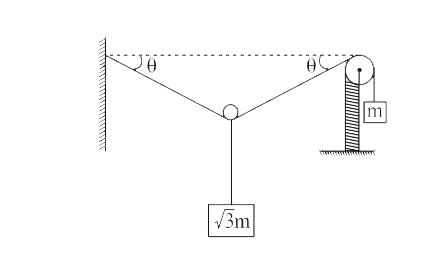Two system in thermal equilibrium with a third system separately are in thermal equilibrium with each other. The above statement is
First law of thermaodynamics
Second law of thermodynamics
Third law of thermodynamics
Zeroth law of thermodynamics
The correct Answer is:D
To solve the question regarding the thermal equilibrium of two systems with a third system, we can break it down step by step.
1. Understanding Thermal Equilibrium:
- Thermal equilibrium occurs when two systems are at the same temperature and there is no net flow of thermal energy between them.
2. Identifying the Systems:
- Let's denote the systems as A, B, and C.
- According to the question, systems A and B are each in thermal equilibrium with a third system C.
3. Applying the Concept of Thermal Equilibrium:
- If system A is in thermal equilibrium with system C, it means that their temperatures are equal (T_A = T_C).
- Similarly, if system B is in thermal equilibrium with system C, then T_B = T_C.
4. Concluding the Relationship:
- Since both A and B are in thermal equilibrium with C, and both have the same temperature as C, we can conclude that T_A = T_B.
- Therefore, systems A and B must also be in thermal equilibrium with each other.
5. Identifying the Law:
- This principle is known as the Zeroth Law of Thermodynamics, which states that if two systems are each in thermal equilibrium with a third system, they are in thermal equilibrium with each other.
6. Final Answer:
- The statement provided in the question is an expression of the Zeroth Law of Thermodynamics.
Conclusion:
- The correct answer to the question is Zeroth Law of Thermodynamics.
---
- Thermal equilibrium occurs when two systems are at the same temperature and there is no net flow of thermal energy between them.
- Let's denote the systems as A, B, and C.
- According to the question, systems A and B are each in thermal equilibrium with a third system C.
- If system A is in thermal equilibrium with system C, it means that their temperatures are equal (T_A = T_C).
- Similarly, if system B is in thermal equilibrium with system C, then T_B = T_C.
- Since both A and B are in thermal equilibrium with C, and both have the same temperature as C, we can conclude that T_A = T_B.
- Therefore, systems A and B must also be in thermal equilibrium with each other.
- This principle is known as the Zeroth Law of Thermodynamics, which states that if two systems are each in thermal equilibrium with a third system, they are in thermal equilibrium with each other.
- The statement provided in the question is an expression of the Zeroth Law of Thermodynamics.
- The correct answer to the question is Zeroth Law of Thermodynamics.
Topper's Solved these Questions
- THERMODYNAMICSBOOK - NCERT FINGERTPS ENGLISHCHAPTER - THERMODYNAMICSEXERCISE - HOTs
8 Videos
- THERMODYNAMICSBOOK - NCERT FINGERTPS ENGLISHCHAPTER - THERMODYNAMICSEXERCISE - Assertion & Reason
15 Videos
- THERMAL PROPERTIES OF MATTERBOOK - NCERT FINGERTPS ENGLISHCHAPTER - THERMAL PROPERTIES OF MATTEREXERCISE - Assertion And Reason
10 Videos
- UNITS AND MEASUREMENTSBOOK - NCERT FINGERTPS ENGLISHCHAPTER - UNITS AND MEASUREMENTSEXERCISE - Assertion And Reason
15 Videos
Similar Questions
Assertion: Two systems, which are in thermal equilibrium with a third system, are in thermal equilibrium with each other.
Reason: The heat flows spontaneously from a system at a higher temp. to a system at a lower temp.
View SolutionTwo bodies A and B are said to be in thermal equilibrium with each other if they have same
View SolutionA system X is neither in thermal equilibrium with Y nor with Z. The systems Y and Z
View SolutionWhat is meant by thermal equilibrium?
View Solution''The earth is not in thermal equilibrium with the sun.'' Why ?
View SolutionWhen are the two bodies in thermal equilibrium?
View Solutionwhen two bodies A and B are in thermal equilibrium then
View SolutionThe system is in equilibrium. Find the angle θ

View SolutionIf two bodies are in thermal equilibrium in one frame, will they be in the thermal equilibrium in all frames?
View SolutionThere is no transfer of heat at thermal equilibrium.
View Solution
